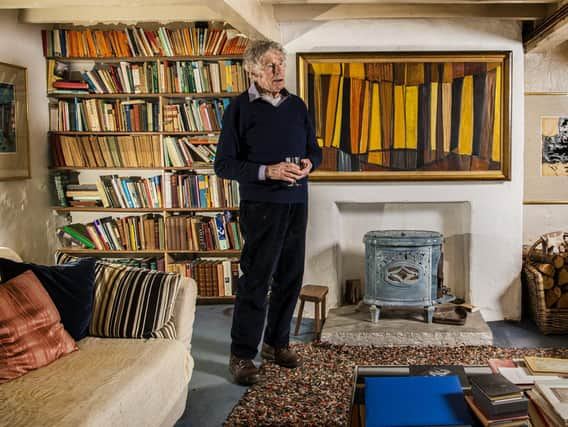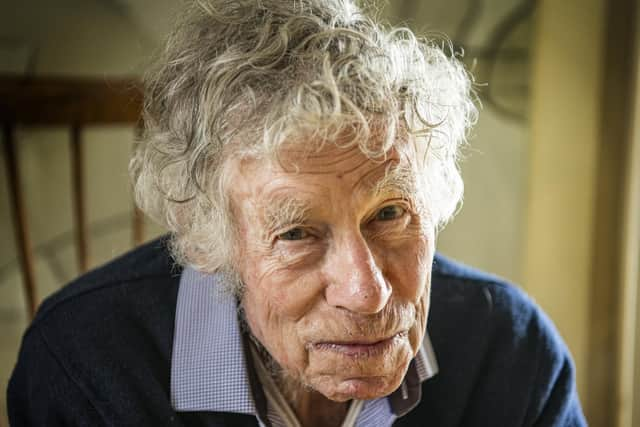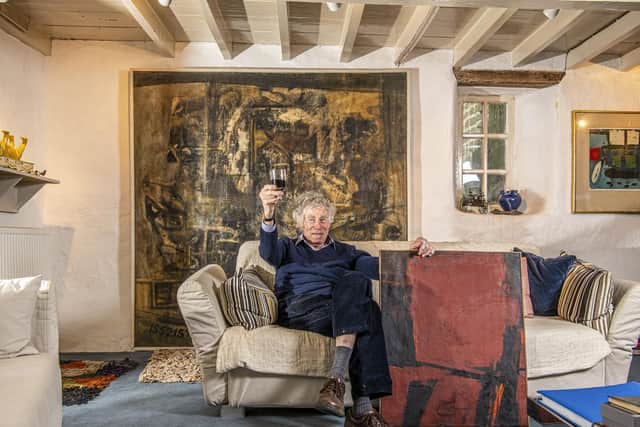Yorkshire art collector Ronnie Duncan on why he bequeathed works to the Hepworth Wakefield


It is over 70 years since Ronnie Duncan bought his first painting, a small, brightly coloured abstract crowd scene that he picked up somewhere near Hampstead Heath. That initial purchase, back in 1948, turned out to be the beginning of a lifelong passion and the foundation of what has become a nationally significant collection of contemporary art.
Now numbering around 300 pieces, much of Duncan’s collection – which includes paintings, drawings, sculptures and ceramics – surrounds him at his stone cottage home, where he has lived for more than six decades, a few miles from Otley. It is clear that for Duncan collecting art is, and always has been, about love and not about playing a financial long game.
Advertisement
Hide AdAdvertisement
Hide Ad“I have never bought a piece of art as an investment,” he says. “I have only ever collected work I really like and that has remained my guiding principle.”


Of that very first acquisition he says: “I still love it, the fact that it is still here means that I do – and no one will have heard of the artist, but that doesn’t matter.” He is a great believer that art is for living alongside, appreciating day to day and sharing with others. “I absolutely believe that art should be bought to live with. Art is for everybody – I am a passionate advocate for free entry to art galleries – and we are only custodians of our possessions.”
This generous philosophy means that artworks from his collection are frequently out on loan and he has recently bequeathed to the Hepworth Wakefield a major gift of around 30 paintings and drawings by artists including Trevor Bell, Alan Davie, Terry Frost, Roger Hilton and Ian Hamilton Finlay. Duncan is “a great admirer” of the gallery and has regularly loaned artworks from his collection for their exhibitions in the past; the bequest is made in tribute to a former director of Wakefield Art Gallery, Helen Kapp, who was Duncan’s friend and mentor for many years.
“She was a truly remarkable woman who mentored me in my earliest collecting days,” he says. “She introduced me to the work of lots of different artists and she was instrumental in building Wakefield’s excellent collection of mid-century British art.”
Advertisement
Hide AdAdvertisement
Hide AdKapp was director at Wakefield from 1951 to 1961 and during that period she led an innovative, creative exhibition programme and also oversaw the acquisition of work by L S Lowry, Henry Moore and many others.


She launched the annual show Modern Art in Yorkshire giving contemporary living artists small-scale solo shows which was quite a rare and radical move for a regional museum at the time. It was Kapp who curated the 1958 exhibition of work by the Scottish abstract artist Alan Davie which impressed a young David Hockney so much when he visited that he began to explore abstraction in his own painting.
“Helen played an important part in establishing the careers of many of the artists who I have been fortunate to know and whose work has so enriched my life,” says Duncan. “I wanted my gift to be a celebration of Helen, so most of the works are by artists that in the broadest sense she was working with.”
Duncan’s interest in collecting art “came out of nowhere”, he says, and although as a teenager he had ambitions to a literary and artistic life (“poetry was my first love”), he admits: “I fairly quickly came to the bitter realisation that I would never make an artist.”
Advertisement
Hide AdAdvertisement
Hide AdAfter studying English and History at St Andrew’s and Oxford, Duncan came back to Yorkshire in the early 1950s to join the long-established family business of worsted spinners, becoming the fifth generation to head up the William Ackroyd and Company textile mill in Otley.
Duncan’s return to Yorkshire coincided with the establishment at Leeds University of the Gregory Fellowships, a scheme which invited contemporary poets and artists to spend a funded period at the University, sharing their work and creative ideas with the academic community there. Helen Kapp was a great supporter of the scheme and she showcased the work of many of the Gregory fellows at Wakefield Art Gallery introducing them to a wider audience.
For Duncan it was an opportunity to learn more about the art, and the artists, he was interested in. “I often think I am the greatest beneficiary of those Fellowships – it was a very exciting time to be around,” he says. “In so far as circumstances would allow, I did get to know the artists, bringing me closer to them as creative people and really in some cases those connections developed into some of the most meaningful friendships of my life.”
He credits Terry Frost with introducing him to the abstract British art of the 1950s and 60s that now makes up a large proportion of his collection. “I was struggling with abstraction and it was he who changed my mind. He was an ideal introducer – he was such a natural abstract painter and the most delightful personality. He was the most wonderful human being – and that’s how it began. I then met Alan Davie and other artists of that generation, like Patrick Heron, William Scott, Roger Hilton and Ian Hamilton Finlay.”
Advertisement
Hide AdAdvertisement
Hide AdDuncan has a significant number of works in his collection by Finlay.
“With collecting, often chance or luck comes into it, that’s what happened with Ian Hamilton Finlay – I was so early in finding him that I got absolutely outstanding examples of his work which I couldn’t possibly have done once the dreaded art market took him over.”
Inspired by the Scottish poet and artist’s stone garden Little Sparta in the Pentland Hills near Edinburgh, which featured a series of his ‘sculptural poems’, Duncan has created his own beautiful stone garden with the help of local drystone waller Philip Dolphin. It began when he commissioned Finlay to create an antiboreum or sundial in 1976. “It was the only private commission he ever did. I was so lucky to get to know him and his work – it changed the direction of my collecting life because it brought poetry and visual art, my two great passions, together.”
The artworks that cover the walls in each room of Duncan’s home have clearly brought him, and continue to bring him, immense pleasure.
Advertisement
Hide AdAdvertisement
Hide Ad“I regard them a bit like children,” he says. “And as with people you see different aspects at different times. I suppose it is a wonderful way of determining if a piece of work is any good. If it is, it will be multi-faceted in meaning – there will always be something there that takes your eye.”
I ask him whether he has a favourite – acknowledging that it is an unfair question, especially when he has just compared them to children, I add that he doesn’t have to answer. He obliges immediately, without hesitation.
“I love them all, of course, but I think it would be the smallest but one piece in my collection, a work by the Cornish self-taught artist Alfred Wallis that I bought 40 years ago. It is two and a half inches by five and it was painted on the back of a Quaker Oats box. If there was a fire and I could save only one work from the flames, that would be the one.”